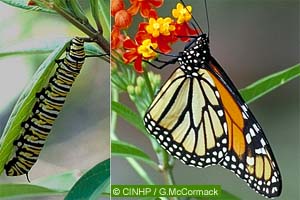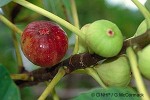Cook Islands Natural Heritage Articles
Cook Islands' Largest Butterfly - the Monarch
 Our largest native butterfly is the Monarch Butterfly (Pepe Renga), which is present on all the Southern Group islands. It is orange and black, with a wingspan to 10cm. It is usually seen near the Red Cottonweed (Tirika, meaning 'silk'), a wayside weed. The adult sucks nectar from a variety of flowers, while the caterpillar requires a plant in the milkweed family, such as Red Cottonweed (aka Butterfly Weed, Bloodflower). The caterpillars grow to 5cm in length, and are covered with narrow yellow, black, and white bands.
Our largest native butterfly is the Monarch Butterfly (Pepe Renga), which is present on all the Southern Group islands. It is orange and black, with a wingspan to 10cm. It is usually seen near the Red Cottonweed (Tirika, meaning 'silk'), a wayside weed. The adult sucks nectar from a variety of flowers, while the caterpillar requires a plant in the milkweed family, such as Red Cottonweed (aka Butterfly Weed, Bloodflower). The caterpillars grow to 5cm in length, and are covered with narrow yellow, black, and white bands.
Colonising the Pacific
The Monarch was originally an American butterfly but as people spread the American milkweeds to other countries the butterfly was able to colonise them – it is now circumtropical. In the Pacific, the first records were: Hawai‘i 1840, Tonga 1863, Samoa 1867, Rarotonga 1869, Tahiti 1872, Queensland 1870. The first New Zealand records were rather confused but it was regularly collected from 1873, with a possible earlier collection in 1868. These dates are consistent with the theory that the butterfly spread naturally by flying from the Americas to Hawai‘i; then to the Fiji-Tonga area; and, then west to Queensland, east to the Cook Islands and French Polynesia, and southwest to New Zealand.
In the Cook Islands the butterfly is present all the year round, while in North America it undertakes a remarkable migratory journey that takes four or five generations to complete each year. In the Cook Islands we have the Long-tailed Cuckoo (Karavia) that migrates each year to New Zealand (3000km each way), and the Pacific Golden-Plover (Tōrea) that breeds each year in Alaska (9,000km each way) – but imagine a butterfly that can fly from southeast Canada to Mexico (4,000km).
The North American Migration
Monarch Butterflies cannot hibernate and therefore they must migrate from cold regions, like southern Canada and most of the USA, to tropical areas, like Mexico or southern California. In the Cook Islands there is no need to migrate, while in parts of New Zealand there is a partial migration of monarchs to a few warmer wintering sites. However, it is in North America that the migration is most remarkable.
In August the monarchs that develop in southern Canada and in central and eastern USA do not reach sexual maturity, and the nectar they drink is stored as fat rather than used to make eggs. During the fall (August – October) they use their efficient soaring flight, and take advantage of favourable winds, to migrate to the mountains of central Mexico, where they hang in crowds in tall trees from November thru January. Under favourable conditions butterflies from Canada can do the 4,000km journey in about two months - averaging around 70km-a-day. The known record for a one-day passage was a tagged butterfly that covered 430km in 24 hours!
They migrate during the day, and rest up at night and during rainstorms. They navigate using the position of the sun, using their biological clock to compensate for its "movement" across the sky, thereby maintaining a steady course to Mexico. If the sun is hidden by cloud they know its position from the pattern of polarised light in any patch of blue sky. While day-to-day navigation is relatively well understood, how they inherit the information to go to particular wintering sites in Mexico is a mystery.
Many butterflies die during the long migration, especially when the weather is unfavourable. For example, in 2004/2005 few butterflies arrived at the El Rosario reserve, one of the five in Mexican sites. They hung in trees covering a mere 2.2hectares – the least successful migration in 14 years. The cause was thought to be adverse weather. By comparison, the most successful migration was in 1996/97 when they occupied 18 hectares at El Rosario – an estimated 160 million butterflies.
In Mexico in the spring, around February and March, the females mature, mate, and start a northward migration laying their eggs on milkweeds as they go. These wintering butterflies die of old age at around 8 months. The northward migration continues with the next generation (the first generation), who take the usual month to become adults and live for up to six weeks, during which time they lay more than 700 eggs. The migration continues until the fourth or five generation, when the shortening days and cooling nights trigger the emergence of the special immature adults. These adults store fat, and undertake the incredible journey to Mexico.
First published December 2005 on this website.
Based on several sources including:
http://www.monarchwatch.org
http://www.learner.org/jnorth/search/Monarch.html
Ram, Anahi (2005) Mexico sees bigger butterfly migration. Reuters, Nov 20. El Rosario, Mexico.
Gibbs, G.W. (1980) New Zealand Butterflies - Identification and Life History. Collins, Auckland.
Moorhouse, Anna (2005) Migrating Monarchs Need UV Light to Stay on the Straight and Narrow Journal of Young Investigators. Vol. 12
About Gerald McCormack
 Gerald McCormack has worked for the Cook Islands Government since 1980. In 1990 he became the director and researcher for the Cook Islands Natural Heritage Project - a Trust since 1999.
He is the lead developer of the Biodiversity Database, which is based on information from local and overseas experts, fieldwork and library research. He is an accomplished photographer.
Gerald McCormack has worked for the Cook Islands Government since 1980. In 1990 he became the director and researcher for the Cook Islands Natural Heritage Project - a Trust since 1999.
He is the lead developer of the Biodiversity Database, which is based on information from local and overseas experts, fieldwork and library research. He is an accomplished photographer.
Citation Information
McCormack, Gerald (2005) Cook Islands' Largest Butterfly - the Monarch. Cook Islands Natural Heritage Trust, Rarotonga. Online at http://cookislands.bishopmuseum.org. ![]()
Please refer to our use policy
